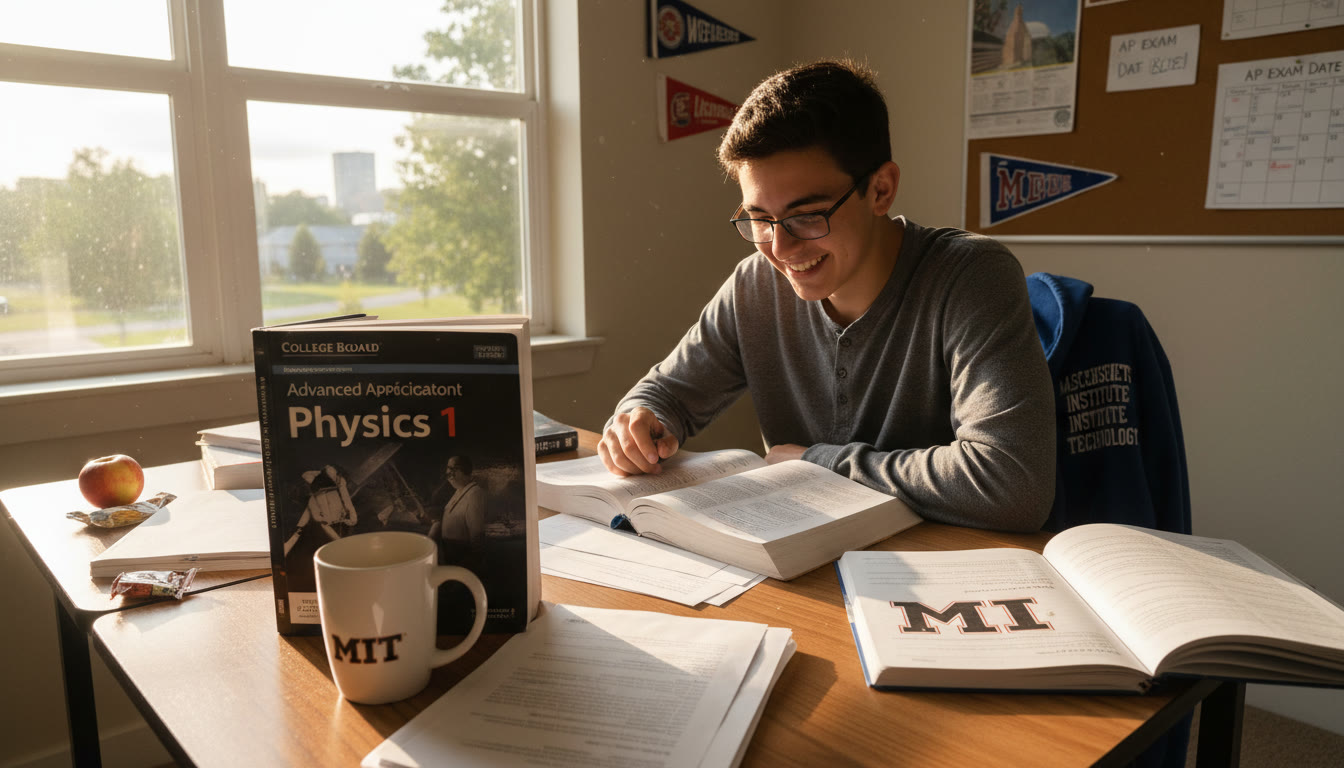MIT: What AP Actually Buys You (And What It Doesn’t)
If you’re a student (or a parent of one) standing at the edge of the AP exam season, you’ve probably heard two powerful, conflicting ideas: that APs are a golden ticket to elite colleges like MIT, and that they’re basically just extra homework with little payoff. The truth sits somewhere beautifully in the middle. At MIT, AP exams can open doors — but they’re rarely the sole thing that opens them. This post will walk you through what AP scores genuinely buy you at MIT (credit? placement? breathing room?), what they don’t (instant guarantees or slimmer application competition), and how to turn AP effort into real benefit with smart choices and help like Sparkl’s personalized tutoring.

Why MIT Admissions and AP Scores Interact (But Aren’t the Same Thing)
First, understand the ecosystem. AP exams are standardized measures that show colleges you’ve attempted college-level work. For MIT, that’s useful evidence: it suggests a student can handle rigorous math, physics, or computer science. But MIT’s admission process is holistic — meaning AP scores are one piece among grades, teacher recommendations, essays, research, extracurriculars, and demonstrated intellectual curiosity.
So what do APs actually influence?
- Admissions Signal: APs demonstrate rigor. A strong AP transcript supports the story you tell in your essays and recommendations about your preparation and interest in challenging subjects.
- Course Placement: High AP scores can let you skip introductory classes and move into more advanced coursework right away.
- Academic Confidence and Flexibility: Skipping intro-level courses gives you room in your schedule for double majors, research, internships, or extra electives.
What AP Scores Do Not Do
It’s just as important to name limits plainly:
- AP is not a guaranteed admission lever. A 5 on Calculus AB doesn’t replace strong essays or research experiences that show a fit for MIT.
- AP may not translate into credit for major-required courses. Some elite engineering programs prefer you take their foundational courses on campus to ensure consistent preparation.
- AP scores aren’t a resume substitute. Real projects, labs, and extended work (research, internships, meaningful club leadership) matter a lot.
How MIT Typically Uses AP Scores (Placement vs. Credit)
There are two practical outcomes when colleges evaluate AP scores: credit and placement. Credit means you earn college credit hours (may shorten time to degree). Placement means you can skip specific introductory courses and enroll in higher-level ones without necessarily earning credit.
At schools like MIT, placement is often more common than full credit for major classes — especially for core engineering and science sequences. Departments often want students to take certain classes in MIT’s curriculum to align backgrounds and expectations.
Common Examples Students See
While policies vary by department and change over time, here are real-world patterns students should expect:
- Calculus AP scores often let students bypass the first calculus sequence or place into a higher-level math course.
- Physics AP scores may allow placement out of the most introductory physics lectures; however, lab experience expectations can require on-campus lab courses.
- Computer Science AP scores (e.g., AP Computer Science A) can permit placement into second-term programming courses, depending on background and departmental checks.
Practical Table: Typical Uses of AP Scores (Conceptual Example)
Below is a simplified, illustrative table to help you visualize the kinds of outcomes AP scores lead to. Remember — actual MIT departmental rules determine precise outcomes.
| AP Exam | High Score Effect (Common) | Likely Outcome at MIT (Illustrative) |
|---|---|---|
| Calculus BC (5) | Skip introductory Calculus sequence | Place into multivariable calculus or advanced math sequence (may not yield full credits toward major core) |
| Physics C: Mechanics (5) | Advanced placement in mechanics courses | May skip some intro lectures; lab course often required on campus |
| Computer Science A (5) | Place into second-level programming courses | Demonstrate coding proficiency in department checks; advanced CS electives possible |
| English Literature (4–5) | Possible placement out of introductory writing or literature course | May still need to take ETHICS/COMMUNICATION requirements as defined by MIT |
Three Student Scenarios: How APs Play Out
Concrete stories help. Below are three common student profiles and how AP results typically affect their MIT experience.
1) The Advanced-Math Applicant
Profile: Strong calculus APs (BC=5), took multivariable privately or via enrichment; extended research in math or applied project work.
What AP buys: Quick entry into higher-level math courses, freeing time for research or advanced electives. This student’s AP scores strengthen their application narrative — but it’s the research and demonstrated problem-solving that seals the fit with MIT.
2) The Physics-Focused Student
Profile: AP Physics C scores of 4–5, summer internships in labs, extensive problem-solving competitions.
What AP buys: Placement advantage in introductory physics; potentially skip a lecture series but still take labs on campus to meet hands-on requirements. AP acts as a credential that supports the application’s academic rigor portion, but labs and research are the major differentiators.
3) The Multi-AP, Broad-Curriculum Student
Profile: A range of APs — calculus, CS, chemistry, and English. Strong extracurricular mix and impactful essays.
What AP buys: Flexibility in first-year scheduling. The student may explore double majors or pursue early research. But MIT will still want evidence of depth — a concentrated project or leadership that shows sustained engagement in a field.
How to Use APs Strategically If You’re Aiming for MIT
APs should be less about collecting every available exam and more about meaningful preparation and demonstration. Here’s a strategic checklist:
- Choose APs that align with your intended major. If you love electrical engineering, prioritize Calculus, Physics C, and relevant math or CS APs.
- Focus on depth in a few subjects rather than shallow breadth across many. A 5 in a major-related AP plus related projects beats five 3s in unrelated subjects.
- Prepare to show application of knowledge. Labs, research experiences, competitions, independent projects, and coding portfolios provide the depth MIT values.
- Don’t rely solely on AP credit to avoid foundational courses if you’ve never experienced that subject’s college-level pace; departments sometimes prefer students to take core classes on campus.
- Use AP placement to plan your first-year schedule: early higher-level courses can free time for research, internships, or double majors.
Quick Study Plan: AP + Application Alignment
This mini-plan helps you pair AP study with application-strength activities across junior and senior years.
- Junior Year: Take core APs (Calculus, Physics, CS). Start at least one research or independent project. Begin drafting essays that connect your intellectual curiosity to activities.
- Summer after Junior Year: Deepen a project or join a lab/internship. Consider subject-matter enrichment that transitions to college-level work.
- Senior Year: Finish AP exams while refining your research/portfolio and obtaining strong teacher recommendations that can speak to college-level performance.
How Much Does an AP Score Actually Save (Time or Money)?
Quantifying value is tempting. AP credit can translate into early graduation, skipping a class, or reduced tuition. However, at selective technical schools, the savings are often on schedule flexibility more than tuition — because even if you earn credit, departments may require you to take specific in-residence classes.
Think of AP value as opportunity cost reclaimed: instead of repeating introductory content, you can spend that semester pursuing research, internships, study abroad, or challenging electives that sharpen your profile for internships and graduate study.
Common Myths — Busted
- Myth: “A 5 on AP guarantees credit for my major.” — Not always. Departments may differentiate between placement and credit, and many core requirements are best completed in-house.
- Myth: “More APs always mean better admission chances.” — Not necessarily. Admissions prefer rigor and fit over sheer volume. Targeted excellence wins over scattershot effort.
- Myth: “You’ll graduate in three years if you take many APs.” — Possible for some students, but uncommon; most students use extra credits to broaden academic experiences instead.
What Admissions Officers at Schools Like MIT Look For — Beyond Scores
AP scores tell part of the story; admissions officers seek evidence of intellectual vitality, persistence, and the potential to contribute to the intellectual community. That shows up in:
- Research projects or independent work with measurable outcomes.
- Long-term commitment to an activity (leadership, consistent focus, improvements).
- Letters that narrate your classroom contributions and growth.
- Essays that reveal curiosity, resilience, and originality.
How to Prepare for APs the Smart Way (Without Burning Out)
Quality beats quantity. The following practical tips help you balance preparation and wellbeing:
- Start early with distributed practice. Weekly problem sets beat frantic weekend cramming.
- Use authentic practice exams under timed conditions to get exam rhythm, not just content familiarity.
- Pair AP study with hands-on application: a coding project for CS, a small lab experiment for physics, or a data-analysis mini-research for statistics. Application deepens understanding and makes essays richer.
- Maintain a healthy schedule with consistent sleep, exercise, and short breaks. High performance is a long-game strategy.
How Personalized Tutoring Helps — Where Sparkl Fits In
Many students find the difference between a good AP score and a great one is coaching that’s tailored to their learning style. Sparkl’s personalized tutoring model offers 1-on-1 guidance, tailored study plans, and expert tutors who can help diagnose weak spots in problem-solving or exam strategy. In particular, Sparkl’s use of individualized planning and AI-driven insights can keep your study efficient — focusing on the exact question types and conceptual gaps that most often cost points on AP exams.
That said, tutoring is most effective when combined with real intellectual work — labs, projects, and deep practice. Think of tutors and tools as accelerants to your own curiosity, not replacements for it.
Decision Flowchart: Should You Take the AP for This Subject?
Not every AP is the right choice. Use this quick decision flow to decide whether to commit to a course or exam:
- Is the AP aligned with your intended major or long-term interest? If yes, consider it.
- Do you have time to develop both exam skills and a deeper project related to the subject? If yes, it’s worth it.
- Will a strong score potentially let you skip introductory content and free time for higher-level work? If yes, excellent reason.
- If the AP is outside your interest and you’re already stretched, skip it — focus on depth in areas that matter to you.
Putting It All Together: A Realistic Game Plan for High-Achieving Students
Here’s a concrete, semester-by-semester view for a student aiming for top schools like MIT who wants to maximize AP advantage without losing depth.
- Junior Year Fall: Enroll in AP classes that align with your intended major. Start one sustained project or research idea. Meet with potential mentors.
- Junior Year Spring: Take AP practice exams periodically. Focus on problem types and develop lab or coding skills that produce artifacts (reports, GitHub repos, posters).
- Summer After Junior Year: Deepen research, take a focused enrichment course if helpful, and prepare for AP exams with timed practice. If helpful, schedule targeted 1-on-1 sessions with a tutor for weak areas — Sparkl can help create a tailored plan here.
- Senior Year: Take exams, refine application essays to highlight intellectual momentum from your AP subjects and projects, and make sure teacher recommendations know your AP and project work well.
Final Thoughts: AP as a Means, Not an End
AP exams matter. They’re a clear signal of academic readiness and can give you schedule flexibility once you arrive at a place like MIT. But the exams themselves rarely do the heavy lifting in admissions or in shaping your college experience. What matters most is what you do with the time and momentum APs create: research that builds skills, projects that demonstrate agency, and coursework that stretches you further.
If you’re preparing for APs with an eye toward MIT, aim for targeted excellence. Use APs to prove readiness and to buy space in your first-year plan. Then fill that space with experiences that showcase curiosity, creativity, and resilience — the very traits MIT values most.

Need Help Building a Plan?
If you want a study plan that prioritizes what actually moves the needle for admissions and for learning — not just a list of exams — consider seeking personalized support. Tutors can tailor practice to your specific gaps, help you produce stronger project outcomes, and coach you how to tell a coherent story in your application. For students wanting that extra structure, personalized tutoring and tailored study plans (including AI-driven insights to spot and fix weaknesses) can make months of study far more efficient and less stressful.
Closing Note
Pursuing MIT is an ambitious and exciting path. Think of APs as strategic tools: they can validate your readiness, open curricular doors, and give you precious time to explore. But the true advantage comes from combining AP success with sustained, curiosity-driven work that shows you’re not only prepared — you’re ready to contribute. Keep your eyes on the long game: knowledge, creativity, and meaningful contribution are the currency MIT values most.


















No Comments
Leave a comment Cancel